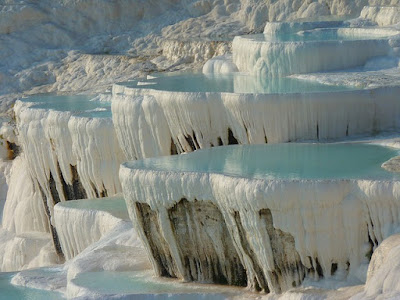Pamukkale's Travertine Terraces
In southwestern Turkey, near the ruins of Hierapolis, is a site that looks mighty cold. Frozen waterfalls, lots of white stuff, called the "Cotton Castle" — but plenty warm because of the hot springs. That white stuff is travertine, formed by the minerals in the water. People have visited this place called Pamukkale for the mineral waters over thousands of years, and it is a World Heritage Site according to UNESCO. That means you can visit the ancient pagan relic and swim in the "sacred" waters. I don't give pagan stuff no nevermind, it might be fun.
Using uniformitarian assumptions (current processes are what have always happened over many years), geologists say that Cotton Castle was built up over thousands of years. But we've seen how uniformitarian assumptions have failed to explain the data many times, and biblical creationist models using the Genesis Flood have explained data far better. Once again, the Flood model gives the Cotton Castle a much younger age.
 |
| Image credit: Pamukkale / LoggaWiggler / Pixabay |
Every year “Cotton Castle” in Turkey attracts a million visitors, who are eager to see its spectacular stepped terraces and “frozen” waterfalls, or to find refreshment in its oyster-shaped mineral pools. Today the region is called Pamukkale (Turkish for “cotton castle”). But in New Testament times it was part of the thriving city of Hierapolis, famed for the healing qualities of its hot mineral springs. (In Revelation 3:15–16 Christ condemned the church at Laodicea for not being “hot” like the healing waters flowing down from nearby Hierapolis.)To read the rest of this hot subject, rock on over to "Cotton Castle".
This elaborate “white castle” sprawls more than a mile (8,860 feet, 2,700 m) across the hillside. Its blazing white stones really do look like a magical castle floating in the clouds. Evolutionary geologists say it formed slowly over tens of thousands of years, as chemicals in the water precipitated out.